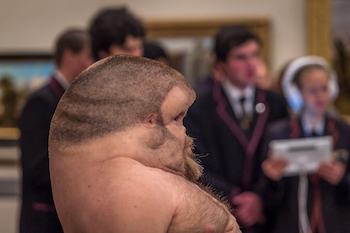The Sultan’s Elephant, Royal de Luxe, 2006. Produced by Artichoke in London. Photo by Sophie Laslett.
The capacity for the arts to change minds and create change is well documented. This can happen when a single work of art influences and affects the opinion of one individual, or even an entire generation, and when a project instigates social change in a community.
The Victorian Government’s recently announced the Creative State Commissions aim to do just that. Large-scale, ambitious, and impactful — the call out issued by Creative Victoria is for work that generates long-term social, cultural, or economic outcomes. In other words, they want artists who aim to change the world.
Visit creative.vic.gov.au to find out more
ArtsHub has compiled a list of bold art projects and initiatives (some local, some international) that have impacted the lives of individuals and communities. Although this impact occurs and is measured in very different ways, many of the projects listed are fearless in the approach to scale and creativity.
Silo Art Trail
One of the biggest regional art projects in Australia, the Silo Art Trail stretches over 200km across the Wimmera and Mallee, from Rupanyup all the way to Patchewollock. The giant forms of grain silos are painted by renowned Australian and international artists, with each work reflecting the local community where the silo is located. The project is reinvigorating the economy of these regional towns with an influx of tourists and international media attention.
The Sultan’s Elephant
In 2006, Royal de Luxe’s The Sultan’s Elephant came to London. Produced by company Artichoke, the oversized marionette’s travelled at 1.5km per hour down public streets, with fifty volunteers and 115 members of Royal de Luxe bringing the the story of a time-travelling elephant in search of a girl to life. But it wasn’t only a great performance. The work became a landmark piece of outdoor theatre that transformed public space and created a huge emotional impact as a live experience shared by 1 million people.
One & Other
Public art project One & Other by Antony Gormley (2009) staged a public occupation of the north-west plinth in Trafalgar Square, London. For 100 days, 24 hours a day, a volunteer took up residence on the vacant plinth for one hour with 2,400 people participating. Gormley commented that the project ‘allows us to reflect on the diversity, vulnerability, and particularity of the individual in contemporary society,’ an aim thrown into sharp relief given the masculinist history of the site as a monument to military conquest.
Future Library
The Future Library is an exercise in preservation. Artist Katie Paterson designed the art project to run for 100 years, allowing time for the 1000 spruce trees she planted in a forest outside Oslo in Norway to grow. Each year a writer is selected to contribute a new manuscript the library, which remains unread until 2114, at which time the trees will be turned into paper for the publication. So far, Margaret Atwood, David Mitchell, and Icelandic novelist Sjon have contributed manuscripts. The project has received International media attention and is suggestive of an evolving “slow art” movement that connects with issues of sustainability and conservation for the next generation.
Graham

A collaboration between artist Patricia Picinnini and the Transport Accident Commission led to the creation of an interactive sculpture better known as “Graham.” Designed to remind people of human vulnerability on roads, the initial launch of the campaign drew mass attention to the issue of road safety, with Graham quickly becoming the #1 trending topic on Twitter, Facebook and Reddit and generating 31 million video views and 80,000 shares. The website alone generated 1.9 million views from 186 different countries during the initial launch, and more than 80,000 visitors have spent time exploring Graham in person, with one in seven visitors being from regional areas.
Smog Free Project
Dutch artist Daan Roosegaarde is a frontrunner in art driven by ethical and social design principles. The Smog Free Project designed by Studio Roosegaarde aims to reduce air pollution in some of the most adversely affected cities on the planet. The Smog Free Tower, for example, is described as “the world’s largest smog vacuum cleaner” and uses positive ionisation technology to improve air quality in public space. The newest addition to the project is the Smog Free Bicycle. Studio Roosegaarde has joined forces with the Chinese bike sharing program, ofo, to develop an innovative bicycle that inhales polluted air and cleans it.
Cathy Come Home
The TV drama Cathy Come Home instigated change in the way homeless people were treated in Britain in the 1960s and became one of the most influential program in history. Directed by Ken Loach, the program follows a young family struggling with the reality of poverty, where families were left without a home and split up as fathers were refused accommodation and children were sent into care. The public outrage that ensued led to a re-examination of housing policy across numerous council areas.
Other notable mentions:
- Surrounded Islands and The Floating Piers by Christo and Jeanne-Claude
- The Giants (Perth Festival 2015)
- Matilda the Musical
The Creative State Commissions is an initiative of the Victorian Government’s Creative State strategy. Applications are open to organisations, studios and companies across any creative field. Individuals working in collaboration with an organisation, studio or company can also apply. Visit creative.vic.gov.au to find out more.





